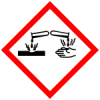Toxicty
GHS safety labels
- H302

Harmful if swallowed
Class: Acute Toxicity
Subclass: Oral - H318

Causes serious eye damage
Class: (Corrosion)Damage/irritation
Subclass: Eye - H332

Harmful if inhaled
Class: Acute Toxicity
Subclass: Inhalation - H351

Suspected of causing cancer (state route of exposure if it is conclusively proven that no other routes of exposure cause the hazard)
Class: Carcinogenicity - H360
May damage fertility or the unborn child (state specific effect if known)(state route of exposure if it is conclusively proven that no other routes of exposure cause the hazard)
Class: Toxic to Reproduction - H362
May cause harm to breast-fed children
Class: Toxic to Reproduction
Subclass: Effects on or via lactation - H372

Causes damage to organs (state all organs affected, if known) through prolonged or repeated exposure (state route of exposure if it is conclusively proven that no other routes of exposure cause the hazard)
Class: STOT
Subclass: Repeated exposure
